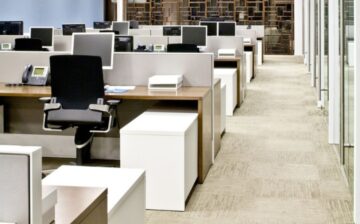Moving to a new office is a bit like throwing a surprise party, right? You never know how your most valuable investment will react. Your staff of course. Moving a corporate office space needs lots of planning, teamwork, and a touch of creativity but most importantly, it needs the support of your staff. Whether you’re a small business owner, upper management, or just the office go-to person, getting your team involved in moving offices successfully can really help with a smooth move. Here we will take you through the ways your team can help aid in your office moving process.

Help with Pre-Move Planning
Form a moving committee
Involving your staff early on is crucial. Encouraging staff to participate in the early stages of planning can foster a sense of ownership and cooperation. Forming a moving committee with representatives from different departments can help in gathering diverse perspectives and addressing specific needs. This diverse team can handle various aspects of the move, ensuring all areas are covered. Assign specific roles and responsibilities to each member, such as coordinating with movers, managing IT equipment, and overseeing the packing process. This delegation not only distributes the workload but also empowers your employees.
Create a timeline
Setting up a clear timeline can aid in the overall office move. Your team can chip in by actively joining the planning, pinpointing key dates for packing and moving, and making sure everyone knows their roles. They can also give regular updates on their progress, keeping things on track and avoiding any last-minute madness. Plus, they can support the workflow and demand during the move to minimize downtime. Key dates could include when to start packing and when different departments will move. Keeping in touch and updating on progress helps everyone stay in the loop about their tasks. A well-organized timeline stops any last-minute craziness and keeps things ticking along smoothly.
Communicate with the team
You’d want to keep communication open and honest during the move too. Make sure to give everyone plenty of heads up about the move, share all the key details like the new office address and any changes coming up with your staff. If they’ve got questions or concerns, make it clear who they can approach and take the time to chat through it all and show them how the new space is a positive move for the overall company and staff. When everyone’s in the know, it helps us all feel connected and less stressed. Tell them your input on the move is valuable, so let’s work together to make the transition smooth and create a cozy new home for everyone.
Packing and Organizing
Personal workspaces
Employees should be responsible for packing their personal belongings. Providing packing materials and guidelines on packing valuables and how to pack with bubble wrap can make this process smoother. Labeling boxes with names and new locations can also help in the unpacking process. To be efficient, guidelines for packing personal items should be clear and straightforward. Encourage employees to label their boxes with their names and departments for easy identification. This step ensures that unpacking is organized, and everyone quickly finds their belongings in the new office. Providing packing supplies and instructions can make this process efficient.
Shared areas and equipment
Staff can help by taking inventory of shared office supplies and equipment, organizing items for easy access, and assisting in packing sensitive or high-value items. They can also oversee specific areas during the move to ensure everything is accounted for and handled with care, reducing the risk of losing important items. They can also assist with creating a plan for packing and transporting sensitive or high-value items. Assign team members to oversee specific areas, ensuring everything is accounted for and handled carefully. This approach minimizes the risk of losing important items during the move.
Declutter and donate
Before packing, staff can help by clearing out and decluttering their workspaces. Encourage employees to sort through their desks, filing cabinets, and storage areas to discard or recycle unnecessary items. This reduces the amount of stuff to move and ensures that only essential items are relocated. Encourage all staff to declutter their workspaces before packing. Organize donation or recycling drives for unnecessary items. This not only reduces the amount of office belongings to move but also promotes a culture of sustainability within your office. Decluttering can be a therapeutic exercise, helping employees start fresh in the new space.
Coordinating with Moving Professionals
Working with movers
On moving day, your staff can play a crucial role in assisting the booked office removalists. Ensure clear pathways and access to the building, making it easier for movers to transport items. Designate employees to guide the movers, answer questions, and address any immediate issues that arise. This coordination ensures a smoother and quicker move.
Technology and IT setup
The IT team plays a very important role in handling the disconnection, migration and setup of IT equipment. Including VOIP network phones, servers, and office computer equipment and assets. The staff can also help by sorting and labelling their own gear, cables, and any extras. This makes it a easy when all staff is accountable for their own equipment and can set it back up together swiftly in the new office spot. This keeps downtime to a minimum and gives everyone a clear timetable for disconnecting, shifting, and reconnecting IT gear and making sure they can all get connected to the office network. When staff are responsible for transporting their own IT equipment such as laptops or tablets it makes it easy for the IT team to setup the rest and keeping productivity on track.
Setting Up the New Office
Unpacking and arranging
Once you arrive at the new office, staff roles in unpacking and organizing are essential. Assign teams to set up personal and shared workspaces efficiently. Having a clear plan for where everything should go speeds up the process and helps everyone settle in quickly. Encourage employees to personalize their spaces to make the new office feel like home. Additionally, having staff help with common areas, such as break rooms and meeting rooms, can speed up the process and create a collaborative atmosphere.
Creating a welcoming environment
Adding personal touches to the new office can significantly impact morale. Consider planning a welcome event or orientation to introduce employees to the new space and its amenities. This not only makes everyone feel comfortable but also fosters a sense of community and excitement about the change.
After the Office Move
Feedback and adjustments
After the move, staff can offer valuable feedback on what worked well and what could be improved. This information can be useful for future relocations and for fine-tuning the current setup to better meet employees’ needs. Use surveys or meetings to gather insights about what works and what needs improvement. Making necessary adjustments based on this feedback shows that you value your employees’ opinions and are committed to creating a conducive work environment.
Team building and morale
An office move can be a great opportunity for team building. Organizing activities or social events related to the move can help strengthen team bonds and make the experience more enjoyable. You can engage your team in activities that boost morale and team spirit. Consider organizing team-building exercises or social events to help everyone bond and relax after the move. Celebrating the successful transition is a great way to acknowledge everyone’s hard work and dedication.
Tips to stay on track
- Staying organized – The importance of lists, labels, and clear instructions cannot be overstated. Maintain an inventory of packed items and their destinations in the new office. This organization ensures that nothing is misplaced and that unpacking is systematic.
- Maintain productivity– During the moving process, it’s important to maintain productivity. Staff can help by creating a schedule that allows them to continue their work while participating in moving activities. Flexible work arrangements, such as working from home or staggered hours, can also be beneficial.
- Maintaining communication – Keeping everyone informed and engaged throughout the process is key. Regular updates about the move’s progress, any changes in plans, and what to expect next keep the team motivated and prepared. Open lines of communication help address concerns promptly.
- Being flexible – Adapting to unexpected challenges and changes is part of any move. Encourage a flexible mindset among your staff, reminding them that flexibility and problem-solving are essential for overcoming unforeseen obstacles. This approach ensures that the move stays on track despite any hiccups.
Conclusion
Involving your team in the office move process can really make a difference! It turns what could be a stressful event into a smooth, team effort. From planning before the move to activities afterwards, having your staff actively engaged at every step makes a big impact. Not only does this make the move more efficient, but it also builds a sense of community and teamwork.
By keeping things organized, communicating clearly, and staying flexible, you can make the office move a positive experience for everyone. Remember, a successful office move isn’t just about shifting furniture, it’s about helping your team transition to a new space where they can thrive and develop.
If you want more advice on managing office moves and creating a positive work environment, reach out to our experts. We’re here to support you at every stage!
We hope you found this blog post on Make Moving Offices Easy With Your Team’s Support, useful. Be sure to check out our post on Ways to Support Employees During a Business Relocation for more great tips!
Have Experience in the Moving Industry? Want an Additional Income Stream? Work With All Around Moving!
If you are interested in applying your skills as a moving relocation consultant in the moving industry, check out our program to earn extra income. Partner with us, and we’ll help you make extra money. Click here to learn more.





